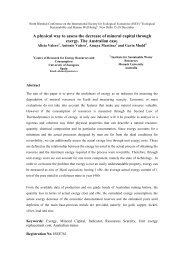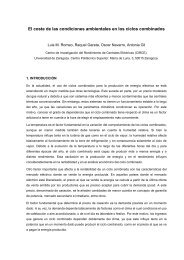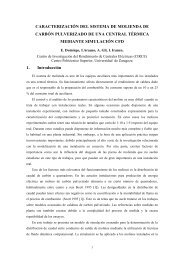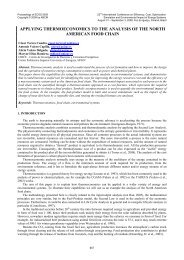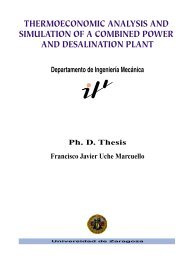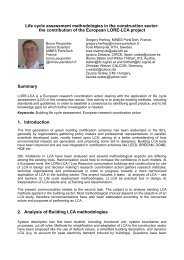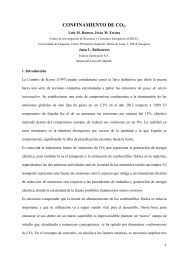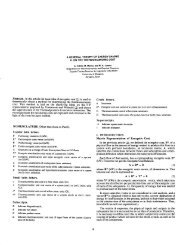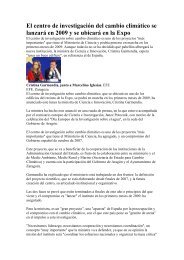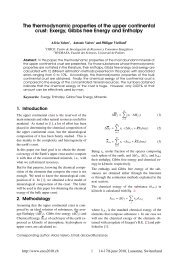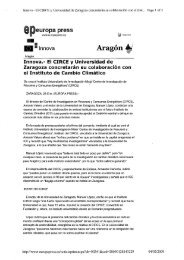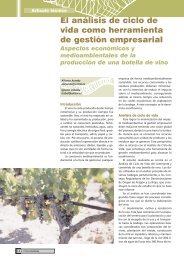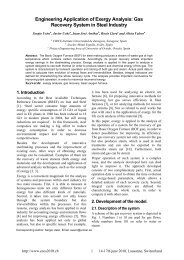CHARACTERIZATION OF A BIOMASS MILLING PILOT ... - circe
CHARACTERIZATION OF A BIOMASS MILLING PILOT ... - circe
CHARACTERIZATION OF A BIOMASS MILLING PILOT ... - circe
Create successful ePaper yourself
Turn your PDF publications into a flip-book with our unique Google optimized e-Paper software.
used to convey the particles from mill outlet to other<br />
equipments of handling, storing, treatmeant or directly to<br />
consume milled biomass.<br />
Usually, mills are composed by rotating elements<br />
inside the grinding chamber and at high revolutions The<br />
material circulates around the mill along paths parallel to<br />
the screen surface making the openings are only partially<br />
effective [13].<br />
This rotating flow produces an oblique particle<br />
trajectory to the screen (e.g. Fig. 2). Therefore the<br />
probability of particle evacuation through screen<br />
openings decreases. Higher angle between normal to the<br />
screen and particle trajectory causes higher probability of<br />
impact against the screen and bounce back into the<br />
impact zone where non necessary impacts may happen.<br />
Working under negative pressure in the mill exit<br />
modifies the air stream and the trajectory of fine particles<br />
against the internal screen, increasing the particle<br />
evacuation probability of grinding chamber. Inertial<br />
effect predominates on coarser particles due to their<br />
higher mass and high velocity after impact.<br />
Figure.2: Particle impact trajectory against the internal<br />
screen.<br />
On the other side, high negative pressure may<br />
produce screen blinding since the particles leave so far<br />
the impact zone blocking the screen. After the impact,<br />
high negative pressure hinder the bounce particle,<br />
remaining against the screen and decreasing the screen<br />
effective surface. Under the most unfavorables<br />
conditions, biomass can totally blind the screen and cause<br />
the stop of mill drive and the stop of the process.<br />
Negative pressure is controlled by means of variable<br />
speed drive installed in fans. These electronic devices<br />
vary the rotary revolutions of fan blades, increasing or<br />
decreasing the suction in the mill outlet.<br />
To assess the influence of this parameter in the<br />
properties of milled material and milling energy<br />
consumption it has been necessary to install pressure<br />
transducers in both mills outlets. Negative pressure is<br />
obtained, registred and saved for data processing.<br />
The parameter study allows to determine:<br />
Upper limit of negative pressure without<br />
blinding<br />
Optimal pressure to decrease the milling<br />
energy requirement<br />
Their influence in the pulverized biomass<br />
properties<br />
3.1.2 Speed of rotation<br />
Speed of rotation influences residence time in two<br />
aspects:<br />
Released energy in impacts<br />
Rotating air-particles flow inside the grinding<br />
chamber<br />
3.1.2.1 Impact energy<br />
Residence time depends on breaking velocity, i.e. the<br />
velocity at which the particle is fractured until it achieves<br />
a lower size than the screen opening size. In the case of<br />
hammer mill, the fragmentation (creation of new<br />
surfaces) is influenced by the energy released in impact.<br />
The impact energy is entirely in the form of the relative<br />
kinetic energy between the particle and the point of<br />
hammer where the impact happens.<br />
2<br />
r<br />
I = mν<br />
/ 2 = m ⋅ ( ν −ν<br />
) / 2 = m ⋅ ( r ⋅ω<br />
− v<br />
m<br />
p<br />
m<br />
p<br />
) / 2<br />
Where m is the particle mass, vr the relative lineal<br />
velocity between the particle velocity (vp), and velocity<br />
of the impact point in hammer (vm),r radius from mill<br />
axis to impact point in hammer and ωm the hammers<br />
angular velocity.<br />
Lower angular velocity ωm implies lower impact<br />
energy and lower particle fragmentation. Therefore, the<br />
original particle needs a higher number of impacts until<br />
the suitable size is achieved, increasing the residence<br />
time of particle in grinding chamber.<br />
3.1.2.2 Rotating air-particle flow inside the grinding<br />
chamber<br />
Higher angular velocity of internal elements produces<br />
higher rotating air-particle flow effect inside the chamber.<br />
As it is explained in section 3.1.1, this effect increases the<br />
angle between the particle trajectory and normal to the<br />
screen and decreases the probability of particle<br />
evacuation of the chamber.<br />
3.2 Drying effect during milling<br />
Grinding process causes significant secondary effects<br />
in final milled product. One of those is the mositure<br />
content reduction.<br />
Drying effect is caused by the heat released through<br />
two processes:<br />
Global drying: particles are in air-particles<br />
turbulent atmosphere receiving constantly heat<br />
flows from friction process between the mobile<br />
elements and between this elements and the airparticle<br />
flow.<br />
Local drying: It is caused by the evaporation of<br />
water content in particle due to released heat in<br />
impact. As the particle strikes and compresses,<br />
some of the kinetic energy is converted to strain<br />
energy in the compressed particle, with the sum<br />
of strain energy and kinetic energy equal to the<br />
impact energy. When the strain energy reaches<br />
that required to cause fracture, some of the<br />
stored strain energy is used to create new<br />
surfaces and the rest is converted to heat by<br />
relaxation of the fragments of breakage [14].<br />
The released heat as from friction process as from<br />
particle relaxation after impact is difficult to quantify. For<br />
this reason, a global energy balance in mill is raised. The<br />
objective is to determinate quantitevily the disiped and<br />
inverted energy in drying effect by means of the<br />
numerical value determination of implicit variables<br />
regarding as air as biomass:<br />
Input and output temperature<br />
Input and output air humidity and biomass<br />
moisture content<br />
Biomass feed rate and air mass flow<br />
3.2.1 Input and output temperature<br />
In practice, air-particle flow temperature inside the<br />
grinding chamber is increased during the milling.



